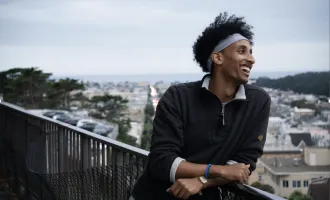One Eighth An MD
It’s hard to believe that only five and a half months ago I anticipated sacrificing all free weekends, dreaded walking up the seriously underestimated hills of San Francisco, and walked into class with nonexistent anatomy knowledge among other things.
With a preconceived picture of what medical school would look like, I entered UCSF grateful, excited, and anxious.
Fast forward a few months. I don’t know how the time passed by so quickly.
My answer to friends and family who ask me for medical advice is still, “Well, my hopeful thinking tells me maybe I could reason through your problem, but really you’re better off asking me again in four years.”
But now I’m in the trenches and supposedly well on my way to being competent enough to be responsible for patients.
To many of the first year class, medical school has been similar to riding a roller coaster.
We’ve had weeks when about 90% of our time was either spent in class or with our noses deep in our course material, namely the Airway, Blood, and Circulation (ABC) block.
But there have also been weeks with unexpected free time to leave the medical school bubble and take advantage of California nature, visit friends and family, or just sit on a couch to watch TV and read a book.
Each week has brought something different. Here’s my attempt at summarizing what coursework during a typical week looks like.
Prep work for the week usually involves 3 to 8 online video or interactive lessons, course reading, four small group problem sets, CMC clinical skills prep, and inquiry small group case research.
Sunday: Last attempts to finish as much prep as possible to avoid falling behind
Monday: 8-12 pm Lecture; 1-3/4 pm Inquiry Small Group
Tuesday: 8-12 pm Anatomy Lab/Foundational Science (FS) Small Groups
Wednesday: 1-5 pm FS Small Groups
Thursday: 8-11:30 am CMC Microsystem; 1-5 pm CMC Clinical Skills
Friday: 8-12 pm Lecture; 1-3 pm Office Hours
We spend countless hours navigating foundational science material, but arguably the best part of our weeks are the clinical skills sessions when we learn to take a patient history, write a medical note, and perform physical exams to name a few skills.
Sometimes the big picture is lost among the day-to-day work, but patient presentations and visits remind us that what we’re learning in the classroom directly links to caring for others.
While shadowing a physician during my CMC session, I came face to face with that link when I was able to explain the anatomical reasons for the patient’s symptoms of carpal tunnel syndrome after having learned about the syndrome in class that week.
Many of my classmates experienced similar moments with the dawning realization that we will one day be responsible for patients’ quality of life. That’s what spurs us onwards.
The ride so far has been trying, but rewarding. When I’ve needed inspiration, I’ve found it in seminars by world-renowned physicians, researchers, and activists; conversations with other UCSF trainees and faculty; participation in electives, student-run clinics, and student groups; and motivated, friendly, and down-to-earth classmates.
Suffice it to say, medical school so far has been a learning experience and not always in the way we expected.


